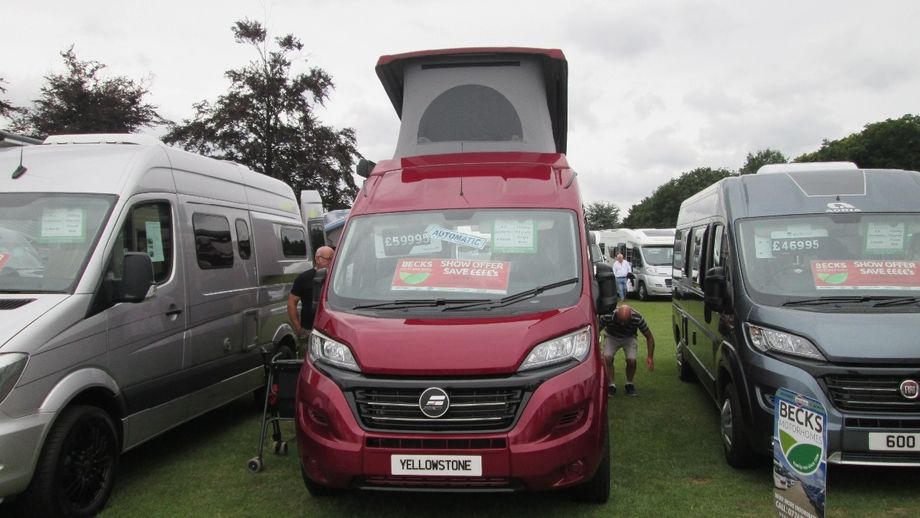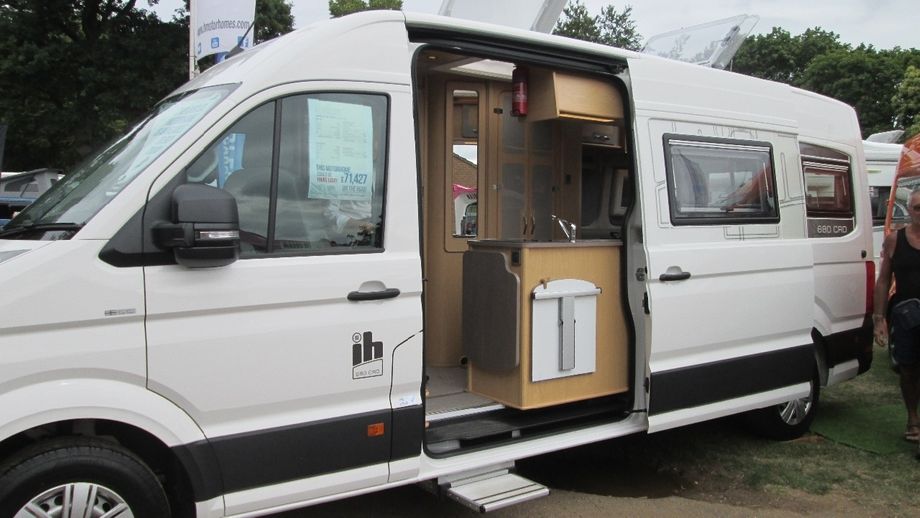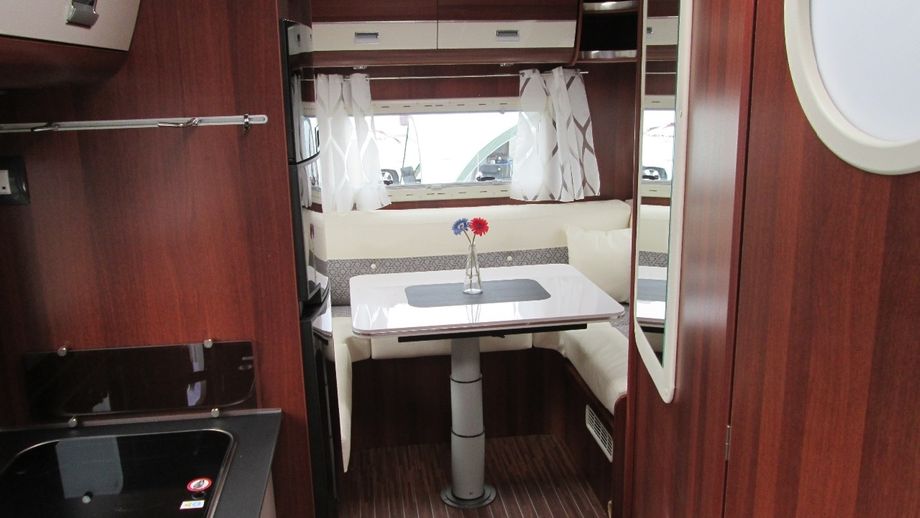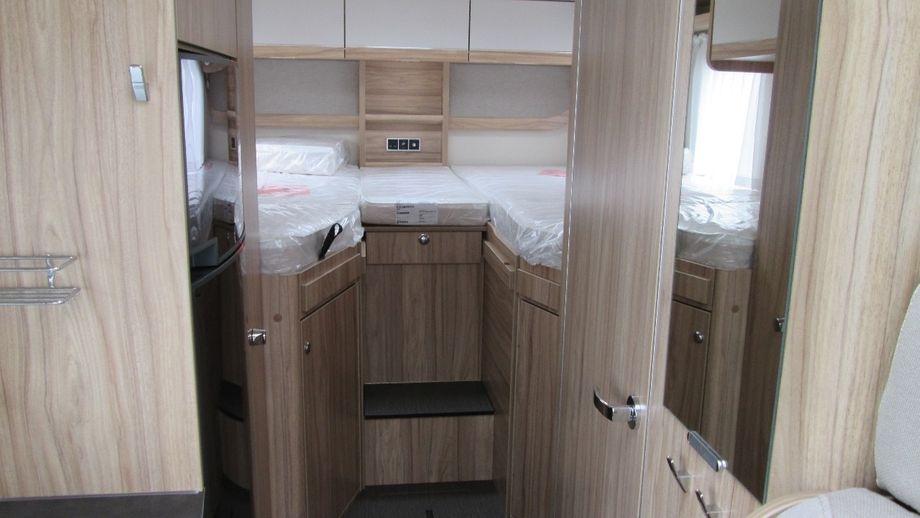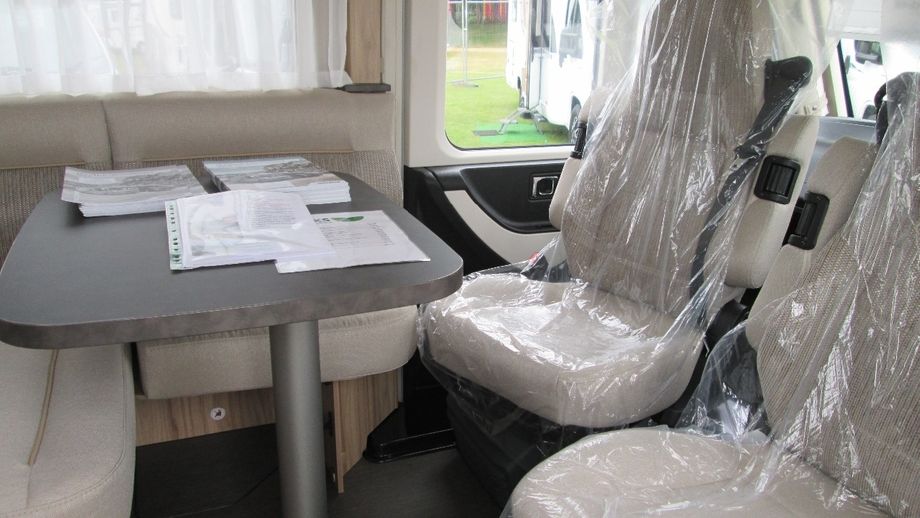Once again I do recommend referring to the Motorhome Monthly Magazine’s website which covers vehicles and advice much better than I can.
The website also has reviews of vehicles tested by their staff over the years and can be easily accessed. Add to that there are lots of video clips on Youtube to look at, so if there is a model you are particularly interested in, then search for a review on the MMM website, as well as seeing if anybody is posting a walk around tour of their own vehicle etc on Youtube.
Finally it is important to point out that most motorhomes offer different layout effecting the beds and storage.
ISLAND BED
This option is the most expensive and tends to increase the length of the vehicle, but does offer the opportunity to walk around the bed on both sides, just like at home.
TRANSVERSE DOUBLE
A fixed double bed running across the back of the vehicle, again offering a large storage ‘garage’ underneath accessed from the outside. This layout reduces the length of the vehicle.
SINGLE
Straightforward enough. Two single beds, one either side with the same large storage area underneath, though do be aware that there is another layout, and that is a bathroom at the rear of the vehicle located through a door between the beds. This layout does not off a large storage facility at the rear.
FRENCH
This layout provides a double bed, usually fairly narrow in the rear corner of the living space with the bathroom and toilet next to it. To ease access to the loo the bottom corner of the bed is usually chopped off at an angle. This layout provides a storage area under the bed accessed either by raising the bed on hydraulic struts or a locker door on the outside.
LOUNGE
This is a throwback to the caravanning days, but does provide a compromise between convenience and space. Basically it’s the sofas in the lounge which double up as beds during the night. This gives a spacious living area, though does give the sofas a 24/7 beating and leaves you having to find space for the bedding during the day (usually under the sofas). ASogood use of the available space but not so good if one of you wants an early night or isn’t feeling too well, and the other wants to stay up and read etc.
It’s easy to tell which camping neighbours have this layout as you hear them clattering and banging as they make up the beds while you lie there listening to them.
POP TOP CAMPERVAN
Sorry, but this is the design of vehicle I just don’t get. If they were as cheap as chips to buy then maybe, but they’re not, costing from around £35,000 up to an astonishing £48,000. They do offer some facilities within a confined space and are easy to drive and park up anywhere, and I assume they must be economical, but for me they’re far too much of a compromise between a family car and comfortable accommodation when touring.
All the internal layouts are pretty much the same, there being insufficient space to be creative. Basically in the back you get a run of cupboards and kitchen space along the offside and not very deep at all, and a two-seater sofa facing forward which are travelling seats for two passengers when on the move, and converts to a bed during the night, usually with the aid of the two cab seats which have to be spun round to become part of the bed. If you’re trying to squeeze four in for a night’s sleep then the roof pops up and the two lucky people get to sleep in a glorified tent on the roof. Life can get complicated if the wind is blowing a gale as then it becomes prudent to drop the roof extension for fear of damaging the rising and lowering mechanism. This happened when we spent two very wet and windy days on the Gower Penninsular last year. In order to avoid damaging the roof mechanism the roofs were lowered. Luckily on this occasion all the vehicles only had couples in them. But if any of them had also contained children, who presumably would have slept up in the roof/tent space. When it had to be lowered, where would they have then slept?
Add to that the lack of even the most basic of portable toilet on most models due to the lack of space, then surely you have to question the wisdom of splashing out that kind of money. Some models do have a small chemical toilet in a cupboard located under the kitchen unit – nice, but to use it you’d have to pull it out, then close the curtains for privacy. Come night time of course that luxury is not available to you as the loo is trapped in the cupboard by the unfolded sofa-cum-bed leaving you to walk to the campsite toilet block during the night, and on a wet night be careful not to get the bedding wet as you open the door.
So here’s a tip to other motorhomers – don’t park next to one of these campervans on a campsite, especially if it’s occupied by somebody with a weak bladder.
Woooosh BOOM, as the side sliding door opens and the occupant alights, Woooosh BOOM, as they close the door behind them (these two movements are completed in double quick time when it's raining, to avoid getting the bedding by the door wet). After returning from the toilet block, Woooosh BOOM, as they open the door to climb back in. Woooosh BOOM, as they close the door behind them.
They could reduce the need to slam the door as heavily by opening a window so that the air pressure can be equalised between the interior and outside before closing the door, but that isn’t in the manual.
So if you think that spending that kind of money to sleep in a tent on the roof just so that you can still use the toilet under the sink during the night is good value for money, then good luck to you and happy camping.
Here's another one for those who want to sleep in a tent on the roof.
One of the nicest campervans we saw at this years Norfolk show, at just over £70,000!
HIGHLINE CAMPERVAN
These vehicles are understandably growing in popularity, offering adequate living space within a vehicle which is easily handled by those who lack the experience of driving larger vehicles. It’s just amazing how much can be squeezed in to such vehicles with clever design.
However the thing to remember when considering such vehicles is that you are buying a glorified van – not Dr Who’s Tardis. If it looks small on the outside, then it’s going to be small on the inside. It’s all about how well it’s been designed. And don’t be fooled by online interior photographs of any motorhome. They use an ultra wide-angle lens which makes the space being photographed appear much bigger than it really is.
If viewing these vehicles I do urge you to ask the question “Where do we stow the bedding?” So often that gets missed, and as a consequence that one spacious locker you spotted under a seat, and had all sorts of ideas for how you would use it, ends up stuffed with pillows and duvets, or sleeping bags during the daytime when the bed is returned to seating. Unfortunately both the campervan and these highlines lack storage space.
Personally I wouldn’t want to own one as they lack the interior space I would wish to have. Having had experience of very bad weather when touring America back in 2008 my criteria is ‘If for any reason I had to, could I spend 24 hours locked in this vehicle?’ It’s a good guideline, and for me with panel van conversions the answer would be no. But good luck to those who choose them, I get it, I really do.
LOW-LINE COACHBUILT
The term ‘coachbuilt’ identifies a vehicle which had the habitation (rear living) area constructed in a factory as opposed to a panel van conversion which is nothing more than a van which has had holes cut in it for windows and doors.
The low-line is the most popular style of coachbuilt offering a comfortable living area with an aerodynamic front end, reducing its wind resistance and thus offering better fuel consumption. The habitation area is constructed from aluminium panels and fibreglass mouldings, with insulation in between in interior and exterior.
Like the ‘A’ class various layouts are offered, and the latest models are coming out with some very clever design ideas including drop down beds saving space in the living area.
I do not propose to make any recommendations as to what folk should buy, each individual purchase is very personal, but I did see in a recent copy of Motorhome Monthly Magazine two vehicles which I thought would be very useful for a young family offering adequate living space within a short wheelbase, making them easier to park and store.
BENIMAR TESSORO 413
CHAUSSON 716 WELCOME
The rear lounge which converts in to beds
OVERCAB COACHBUILT
Similar to the low-line, but with the addition of a bedroom above the cab. Designed to provide sufficient beds for a family in a smaller space, or for a couple who do not wish to make the bed up every night using the sofas, these vehicles were once quite popular.
However that bedroom over the cab increases the wind resistance enormously with a resulting reduction in fuel consumption.
Another disadvantage is that heat rises and if travelling in hot weather the heat of the day rises in to the over cab bed-space making it the hottest place in the vehicle, which can make for an uncomfortable night’s sleep.
But if the spec and budget fits the needs of a young family and they don’t travel too many miles each year then these could fit the bill.
Single beds above an external garage
The lounge/cab area
CLASS ‘A’
These are considered the top of the range in the motorhome world and are priced accordingly. For me the main advantage is the greatly increased space in the cab area with no need to duck when you climb into the front seats from the habitation area. Unless you buy a very large and expensive model based on a proper commercial vehicle chassis, these vehicles are built on exactly the same chassis as the low-line coachbuilds, they just don’t use the cabs. This means that when you sit in the driver’s seat there is an awful lot of dashboard in front of you before you get to the front of the vehicle.
If I were to live full-time in a motorhome then this is the type of vehicle to have, otherwise for me all that extra bodywork isn’t worth dragging around.
DEALERS
Below are listed the websites on some of the UK's dealers.





